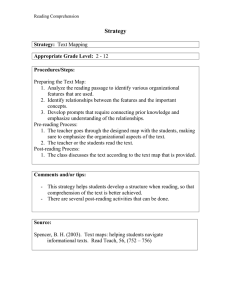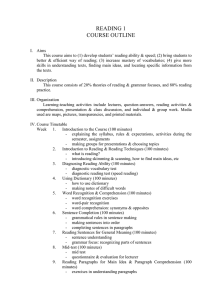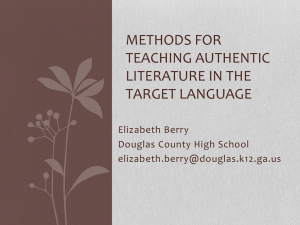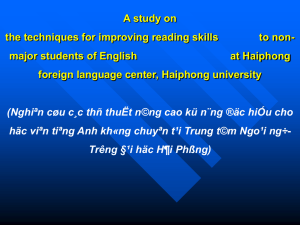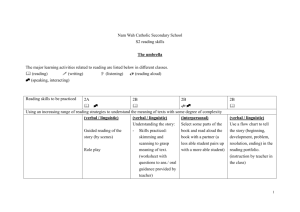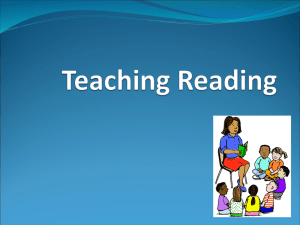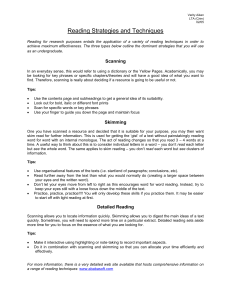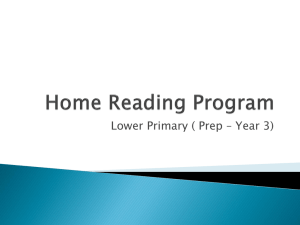1. How do we read?
advertisement
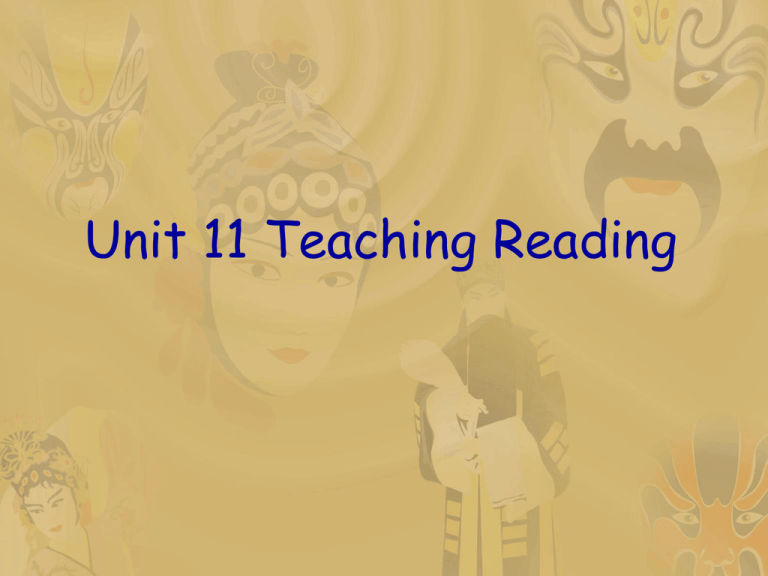
Unit 11 Teaching Reading Teaching objectives know how and what people read grasp strategies involved in reading comprehension know the role of vocabulary in reading grasp principles and models for teaching reading grasp procedures and types of activities in reading Teaching contents How do we read? What do we read? Strategies involved in reading comprehension Principles and models for teaching reading Pre-reading activities While-reading activities Post-reading activities 1. How do we read? 1.1 Reading aloud and silent reading Reading aloud and silent reading are two types of reading practice commonly found in classrooms. reading aloud cannot replace silent reading as it involves only the skills of pronunciation and intonation, while one's real reading ability requires the reading skills of skimming, scanning, predicting, etc. 1.2 What do effective readers do? They have a clear purpose in reading; They read silently; They read phrase by phrase, rather than word by word; They concentrate on the important bits, skim the rest, and skip the insignificant parts; They use different speeds and strategies for different reading tasks; They perceive the information in the target language rather than mentally translate; They guess the meaning of new words from the context, or ignore them; They have and use background information to help understand the text. 2. What do we read? 2.1 Authentic reading materials The reading material must be the kind of material that students will need and want to be able to read when traveling, studying abroad, or using the language in other contexts . 2.2Simulated texts The materials are written esp. for language students with some language control. Simulated texts are aimed for beginner students who are probably not able to handle genuine authentic texts. 3. Skills involved in reading comprehension Understanding the explicitly stated information Understanding conceptual meaning Understanding the communicative value (functions) of sentences Deducing the meaning of unfamiliar lexical items Understanding relations within sentences Understanding relations between sentences Understanding references Recognizing indicators in discourse Recognizing the organization of the text Making inferences Skimming: reading for the gist or main idea. Scanning: reading to look for specific information. 4. Principles for teaching reading ◆ The selected texts and attached tasks should be accessible to the students. ◆Task should be clearly given in advance. ◆Tasks should be designed to encourage selective and intelligent reading for the main meaning. ◆Task should help develop students’ skill rather than test their reading comprehension. ◆Teachers should help the students not merely to cope with one particular text in front of them but with their reading strategies and reading ability in general. ◆Teachers should help the students to read on their own. 4.2 Models for teaching reading ◆ Bottom-up model : a way of teaching reading which follows a linear process from the recognition of letters, to words, to phrases, to sentences, to paragraphs, and then to the meaning of the whole text. ◆ Top-down model: the teacher should teach the background knowledge first so that students equipped with such knowledge will be able to guess meaning from the printed page. ◆ Interactive model not only involves the printed page but also the reader’s knowledge of the language in general, of the world, and of the text types. 5.Three stages of teaching reading 5.1 Pre-reading activities Predicting Setting the scene Skimming Scanning back 5.2 While-reading activities Information transfer activities Reading comprehension questions Understanding references Making inferences 5.3 Post-reading Activities Discussion Role play Gap-filling Retelling False summary Writing back Thank you
